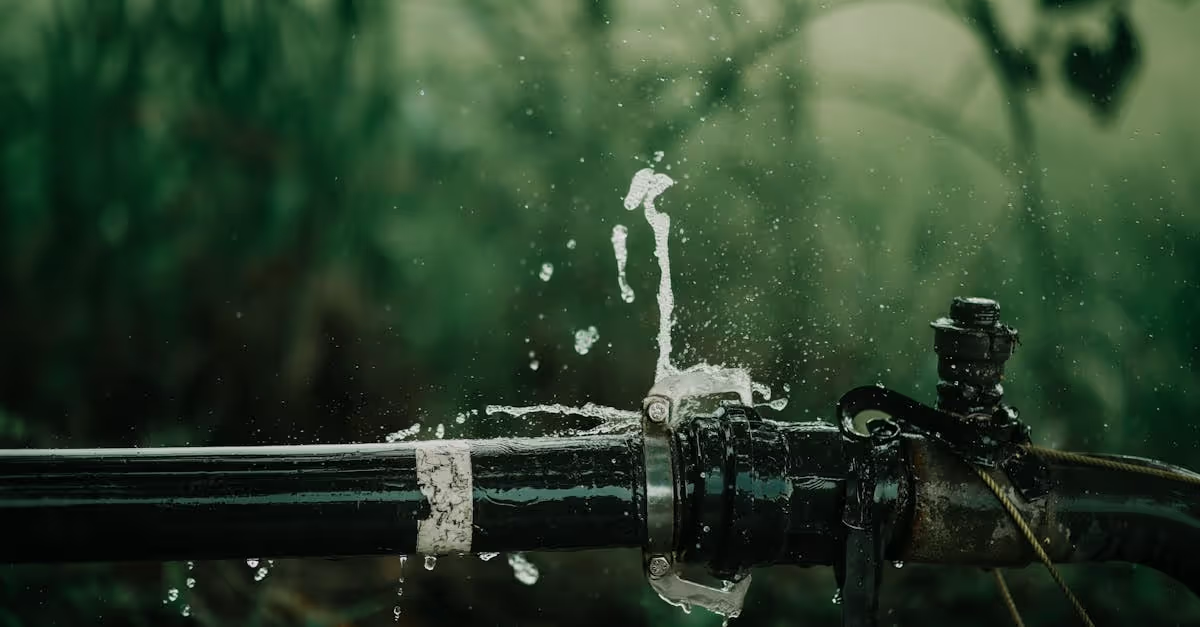Key Takeaways
- Act Fast: Quickly identifying leaks and addressing them is crucial to prevent extensive damage and costly repairs.
- Recognize Signs: Look for indicators of leaks such as water stains, high water bills, musty odors, peeling paint, and dripping sounds.
- Utilize Technology: Tools like moisture meters, infrared cameras, and mobile field service apps enhance leak detection and streamline the repair process.
- Emergency Repair Services: Choose a reliable emergency leak repair service that utilizes field service management software for efficient operations and quicker response times.
- Safety First: For gas leaks or significant structural damage, it’s essential to contact professionals immediately to ensure safety and effective resolution.
- Ongoing Support: Post-repair communication can provide valuable maintenance tips and help prevent future leaks, fostering long-term support from service providers.
Leaks can cause serious damage if left unchecked, with an estimated 10,000 gallons of water wasted per household each year. That's enough to fill a swimming pool! When a leak strikes, it's crucial to act fast to minimize damage and costs. Knowing how to identify leaks early can save us from extensive repairs and hefty bills.
Understanding Emergency Leak Repair Services
Emergency leak repair services play a crucial role in safeguarding our homes from potential damage. Quick identification of leaks prevents costly repairs down the line. When water starts to sneak out from places it shouldn't, acting fast is essential.
Recognizing a leak can often feel like a game of hide-and-seek. Whether it's a damp spot on the ceiling or a water bill that makes us wince, signs of leaks appear in various ways. A musty smell, water stains, or even mold can signal trouble. Familiarizing ourselves with these indicators can set us up for swift action.
When a leak is identified, the next step is addressing it quickly. Emergency repair services generally arrive on-site within a few hours. Technicians often bring with them mobile field service apps that streamline the repair process. These tools help manage jobs efficiently, so we get back to normal life faster. The use of service dispatch software ensures that technicians are appropriately routed, minimizing delays.
We benefit greatly from automated field service solutions. These systems help organize technician schedules, optimize routes, and manage customer engagement effectively. It keeps everyone on the same page and helps us stay informed throughout the repair process. Imagine a pizza delivery service that doesn’t just promise hot, fresh pizza but also tells us exactly when to expect it!
Once on-site, technicians assess the situation and take necessary measures to stop the leak. They may use specialized tools to locate hidden pipes and pinpoint the exact issue. Engaging their expertise ensures that repairs aren’t just patched over; they’re fixed properly.
Post-repair, we often receive follow-up communication through a service business customer portal. This connection keeps us updated on maintenance tips and further assessments to prevent future leaks. We appreciate that companies take the time to check back, not just to fix things but also to offer ongoing support.
When selecting an emergency repair service, look for companies equipped with field service management software. These systems contribute to efficient operations, providing superior service. This investment in technology translates into faster response times and happier customers. Plus, it makes us feel good to support businesses that prioritize us.
Common Types of Leaks
Leaks can occur in various parts of a home. Identifying and addressing them quickly can save us time, money, and unnecessary hassle.
Plumbing Leaks
Plumbing leaks often show up as damp spots, discoloration, or strange odors. Common culprits include faucets, toilets, and water heaters. Regular checks on water usage can reveal hidden leaks. Tools like water leak detectors can be handy for pinpointing the problem. For those who like gadgets, smart leak detectors can provide real-time updates and shut off water flow automatically. Contacting experienced plumbers becomes essential when leaks hide within walls or beneath floors. Quick action prevents extensive damage and costly repairs.
Roof Leaks
Roof leaks can sneak up on us, especially after heavy rainfall. They often start as minor drips but can lead to significant structural issues if ignored. Look for water stains on ceilings or walls. Missing shingles or flashing can signal trouble. Regular roof inspections can spot wear and tear before leaks develop. If water manages to find a way in, reaching out to roofing professionals is critical. They can assess damage and ensure the roof is in tip-top shape. Preventive maintenance extends the life of our roofs and saves money in the long run.
Gas Leaks
Gas leaks pose serious safety risks and demand immediate attention. If we smell gas or hear a hissing sound, the first step is to leave the area and call the gas company. Gas leaks can cause fires or explosions, making swift action essential. Installing gas detectors can add an extra layer of safety. Regular maintenance of gas appliances minimizes the chance of leaks. Always prioritize safety by seeking help from qualified professionals. Taking proactive measures keeps not only our homes safe but also our loved ones.
Identifying Leaks Quickly
Identifying water leaks promptly protects our property and health. Quick detection helps us avoid significant damage and costly repairs.
Signs of a Leak
We can spot several signs indicating the presence of a leak:
- Water Stains: Look for yellow or brownish stains on ceilings or walls. Often, they accompany bubbling or softening of drywall or plaster.
- High Water Bills: Unexplained increases in our water bills often signal hidden leaks. Monitoring our usage helps reveal these issues early.
- Musty Odors: Earthy or musty smells, even after thorough cleaning, often suggest water accumulation behind walls or in crawlspaces.
- Flaking Paint or Wallpaper Bubbles: Peeling paint or wallpaper bubbles signal water seeping behind the walls.
- Dripping Sounds: Noises like dripping, rushing, or flowing water may come from within or behind wall cavities.
Recognizing these signs helps us act swiftly and call for emergency leak repair services.
Tools for Leak Detection
Various tools simplify the leak detection process.
- Moisture Meters: These devices check moisture levels in walls, floors, and ceilings, helping us locate leaks effectively.
- Infrared Cameras: They visualize heat patterns, making it easier to spot hidden leaks without invasive methods.
- Acoustic Listening Devices: These tools detect the sound of water escaping pipes, signaling potential leaks.
- Smoke Testing Equipment: This technique involves blowing smoke into plumbing systems, revealing leaks by watching where the smoke escapes.
Utilizing these tools becomes easier with mobile field service apps. These apps help technicians locate and address leaks more efficiently by streamlining communication and job management. Plus, they offer us a Homeowner Service App, giving us updates and support throughout the repair process.
Addressing Leaks Effectively
Quickly addressing leaks prevents significant damage to our homes. We can act immediately to minimize the effects of leaks.
Immediate Steps to Take
- Turn Off the Water Supply: Shut off the main water supply right away. This stops further damage and limits water flow.
- Contain the Leak: Use buckets or containers to catch water. This simple step helps manage potential flooding.
- Dry the Area: Clean and dry the area with towels or mops. Removing excess water curtails mold growth.
- Check for Visible Damage: Inspect for water damage signs like stains or warping. Early detection aids in repair planning.
- Document the Damage: Take photos before and after repairs. Documenting helps with insurance claims later on.
These immediate actions can make all the difference. Emergencies often create chaos, but we can regain control by following these steps.
When to Contact Professionals
We should consider contacting professionals under specific conditions. If the leak persists after initial measures, it's time to call in the experts.
- Complexity of the Leak: If it’s unclear where the leak originates, expert help is necessary. They use specialized tools like moisture meters and infrared cameras to identify hidden leaks.
- Safety Hazards: Gas leaks or electrical hazards require immediate professional attention. Safety should always come first.
- Extensive Damage: If the leak has caused significant damage like structural issues, we must seek professional repair.
Professionals can restore our homes more effectively. Their expertise and tools optimize repairs, ensuring lasting results. We're part of a community that values securing our homes. So why risk DIY repairs when help is just a call away?
Conclusion
Being proactive about leak detection and repair is essential for protecting our homes. By recognizing the signs early and taking immediate action, we can prevent costly damage and ensure our living spaces remain safe and comfortable.
Utilizing emergency leak repair services allows us to address issues swiftly and effectively. With the right tools and expertise, professionals can provide lasting solutions rather than temporary fixes.
Let’s prioritize regular inspections and stay informed about our home’s plumbing systems. By doing so, we not only safeguard our property but also contribute to a more sustainable environment by conserving water.
Frequently Asked Questions
What are the common signs of a leak in my home?
Leaks can be identified by water stains, musty odors, high water bills, flaking paint, or dripping sounds. Early detection can prevent extensive damage, so it’s important to regularly monitor these signs.
How can I detect leaks early?
Using water leak detectors, regularly checking water usage, and conducting routine inspections can help identify leaks early. Tools like moisture meters and infrared cameras simplify the detection process.
Why are emergency leak repair services important?
Emergency leak repair services are crucial as they provide prompt action to minimize damage and repair costs. They usually respond within a few hours, ensuring leaks are addressed quickly.
How should I respond when I detect a leak?
Immediately turn off the water supply, contain the leak, dry the area, and check for visible damage. Document everything for insurance purposes, as these steps can reduce impact until professionals arrive.
When should I call a professional for a leak?
Call a professional if leaks persist, pose safety hazards, or cause significant damage. Experts have the tools and knowledge to effectively restore leaks, ensuring long-term solutions and safety.
How does field service management software benefit leak repairs?
Field service management software enhances technician scheduling, speeds up response times, and improves customer communication. This technology leads to efficient repairs and higher customer satisfaction.
What types of leaks should I be aware of?
Common leaks include plumbing leaks (faucets, toilets, water heaters), roof leaks (after heavy rain), and gas leaks (appliances). Awareness of these helps in taking preventive action.
What tools are best for leak detection?
Effective leak detection tools include moisture meters, infrared cameras, acoustic listening devices, and smoke testing equipment. These tools can simplify identifying and addressing leaks efficiently.
How much water can leaks waste annually?
Household leaks can waste approximately 10,000 gallons of water annually, which is equivalent to filling a swimming pool. Prompt detection and repair are essential to minimize this wastage.






.svg)
.svg)